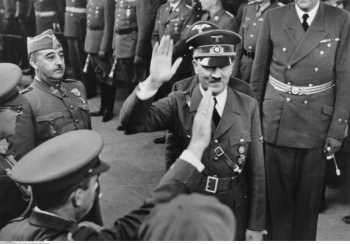Operation Pilgrim – the British plan to snatch the Canary Islands
Many know about the famous meeting in Hendaye between Franco and Hitler and the negotiations maintained by both dictators for Spain to enter the Second World War next to the II Reich.
The historians have written thousands of pages arguing whether Spain’s Generalissimo was an intelligent negotiator who saved Spain from disaster of if Hitler wasn’t prepared to accept the exaggerated petitions from the Caudillo, so as not to upset Vichy in France etc.

The little we do know is while the Austrian hunter and the Galician coup leader were shoulder to shoulder in a German train carriage Erika on the date of October 23 1940, far too the north, British brains were creating plans to counterattack a possible entry of Spain into the war and to leave Spain cut off from honey rum and roasted maize during their invasion of the Canary Islands.

Operation Felix – The German plan to conquer Gibraltar;
In the United Kingdom they feared a Hispanic-Germanic alliance which would threaten the loss of the strategic military base in Gibraltar, and they had reason. Only 20 days after the meeting in Hendaye, Hitler would have met with his son in law Serrano Suñer, to present in fine details the plan to invade Gibraltar on June 10 1941.
So advanced were the plans that, since the end of the 1940’s in the mountainous French province of Besançon they were already training for the assault the German First Mountain Division of General Ludwig Kuebler. For Hitler, the taking of Gibraltar would alleviate the British pressure on their jinx ally, Mussolini, and would have provoked the fall of Malta and Egypt into the hands of the axis.
As admitted the very Winston Churchill ‘Spain has the key in her hand to all the British companies in the Mediterranean’. Why was he concerned about this statistic, when the Spanish had volunteered in the Cuban War, or if Spain would permit or participate in the conquest of Gibraltar?
According to the book ‘History of the non-belligerent Spanish during the Second World War’ (1980) by Victor Morales Lezcano, the occupant of number 10 Downing Street had written to the vice-admiral Alexander on his concern on June 1940:
‘If we have to evacuate Gibraltar, we would immediately invade the Canary Islands, which in turn would be a good military base to control the western entry to the Mediterranean’
The plan to invade the Canary Islands was originally called Puma and was changed to Pilgrim and it should have started at Puerto de la Luz (Las Palmas, Gran Canaria) which would have been taken by two British infantry brigades with the support offshore of one or two boats and to give air cover for an aircraft carrier.
To these naval vessels there would have been at least four merchant ships and other smaller units which would have served for storage, floating deposits of victuals, assault battalions and ammunition. One of the ships to be used to transport the British troops to the Canaries was HMS Queen Emma, a ship with Dutch passengers which sunk of the English coast after the German invasion.
The leader of the naval force, we can read in the June 2015 edition of the Marine Military Magazine (translated) which names Admiral Louis Henry Keppel Hamilton and the ground forces would be led by General Harold Rupert Leofric George Alexander. The latter would have had to capture the strategic airport at Gando, and to neutralise their defence to guarantee the advance towards Las Palmas. Naval amphibious support would have landed at Arinaga Bay to attack Gando from behind.
Another objective as reported in Western Mediterranean and Atlantic Islands Projects of the War Cabinet dated June 13 1940 would be the port at Santa Cruz in Tenerife. In this document the British high command are warned of important Spanish artillery defences guarding the Canary Islands, although the MI6 noted many of them were obsolete, and suggest limiting the attack to one island: Gran Canaria.
‘If we are successful in the operation, the airdrome and port could be used an operations base to attack Tenerife, given the possibility the island would surrender’.
Concentrating on Gran Canaria was not an assured success; in 1994, according to La Opinión de Tenerife, the Captain of the Special Operation Executive (SOE) Austin Baillon, a Briton born on the island, and who then held a conference titled ‘Canaries and the Pilgrim Operation’ in which he recalled in the framework of the program of allied sabotage against belligerent Spain being on the German side, was denominated Golden Eye (designed by Ian Fleming the creator of James Bond) and some 30 commandos including himself who had all received training for parachuting over Tenerife and to sabotage the strategic installations such as the refinery and the Los Rodeos airport.
Would have the Pilgrim operation succeeded or if the Spanish defended Gran Canaria and Tenerife? Is a question answered by Hitler who despite being in Germany was able to smell the sweet odour of Churchill’s cigar, and he expressed his fear of a possible British coup on November 18 1940.
‘We have to place anti-air missiles in the aerodromes on Canaries and take there the Junkers dive bombers, as the only way to definitively defend the islands from the enemy force’.
Winston Churchill told the United States he was thinking of invading the Canaries in the middle of September 1941. However, the evolving war (with Germany facing the titanic invasion from USSR) was when the most important Spanish military men were bribed with hundreds of pounds to become pacifists, and the poor undertaking between Franco and Hitler made the Pilgrim operation unnecessary, with the military assets being diverted and finally used in 1942 in the Ironclad operation to take the island of Madagascar controlled by France at the time.
